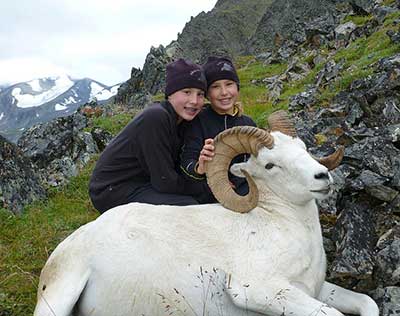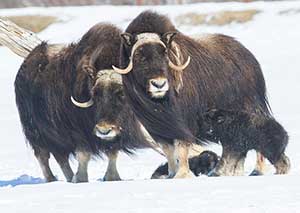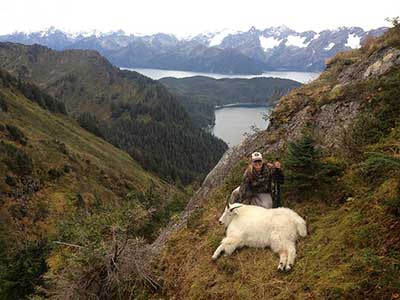Alaska Fish & Wildlife News
February 2014
What are Draw Hunts?
How They Work and Improving the Odds

On Feb. 21, 2014, about 32,000 people will receive news that will profoundly shape their 2014 hunting experiences. That’s when the drawing hunt results are made available.
Much of Alaska’s big game harvest occurs in general season hunts. But like many states, there are hunts where the number of interested hunters exceeds the animals available for harvest. In these cases, Alaska uses a random drawing process to distribute the limited number of hunting permits. This protects the resource and provides some hunting opportunity. Each applicant is entered into the pool and names are selected randomly. Because this year’s drawing does not use information about those drawn in previous years, it is possible that some people will be drawn more than others, by random luck.
Most drawing hunts are available to residents and nonresidents. Application to participate in hunts for most big-game species requires a $5 fee per hunt (the fee is $10 per hunt for bison and muskox), and a hunting license. Hunters can apply for multiple hunts, but in some cases applying for some hunts makes one ineligible for other hunts. Each year, the Alaska Department of Fish and Game publishes a Draw Hunt Supplement with specific information about opportunities and area boundaries. The annual application period is in November and December. The results of the Nov. 1 – Dec. 17, 2013, draw application period will be available online by Friday, Feb. 21, 2014.
Hunters can apply for a maximum of three hunts per species – except in the case of moose, where hunters may apply for up to six different hunts, only three of which may be for bulls – and the chance of winning a permit for a particular species usually increases with each additional hunt. For example, 17 percent of the hunters who applied for only one caribou hunt number won a permit, while 33 percent of the hunters who applied for two caribou hunt numbers won a permit, and 46 percent of those who applied for three caribou hunts won a caribou permit.

On average, hunters apply for about six hunts, keeping their options open and hoping to improve their odds. In 2013, 32,000 hunters applied for 172,000 draw permits in Alaska.
Depending on the hunt, odds range from excellent to astronomical. Odds can be better for hunts in remote, difficult-to-access areas, and remote in Alaska is remoter than anywhere else in the U.S. A few are “undersubscribed,” and for example, 40 people may apply for 60 permits.
It’s not about numbers, it’s about the odds. While 5,554 people applied for a Nelchina area caribou hunt last year, 1,300 permits were issued, putting the odds at about one in four.
The slimmest odds are probably with bison, especially the Delta Junction area bison hunts. Last year 11,320 people applied for 50 permits, placing the odds well below one percent.
Depending on the year, about 35 to 50 permits are issued for a muskox hunt (Nunivak Island). It’s an expensive hunt in a remote area – the resident tag fee is $500 and the nonresident fee is $1,100. Still, about 1,500 people apply, putting the odds at about three percent. But where else in the U.S. can you hunt a muskox?
Compared to other states, odds are pretty good in Alaska. Oregon’s draw hunts for mountain goats and bighorn sheep are a good comparison. The application fee is $8 per hunt. A resident sheep tag costs $122.50, as does a goat tag. A nonresident sheep tag is $1,300.50. A hunting license is $29.50 for a resident and $140.50 for a nonresident.
In Alaska, the application fee is $5 to $10 per hunt. A resident hunting license is $25, and $85 for a nonresident. If a resident wins a sheep or goat tag in the draw, there is no additional fee. If a nonresident wins a draw, a Dall sheep tag is $425 and a mountain goat tag is $300. Nonresident hunters are required to use a guide for sheep and goat hunts.
Oregon is home to about 2,241 bighorn sheep in 44 “watersheds” (2011 estimate). About 90 tags were issued and 84 sheep were harvested in 2009. About 18,000 people applied for those tags. Oregon allows between 5 and 10 percent of the bighorn sheep tags to go to nonresidents, and that year six tags were issued to nonresident hunters. Only one big horn sheep tag is issued to a hunter in a lifetime.

Hunters in Alaska harvested 664 Dall sheep in 2012; nonresidents took 267 sheep and resident hunters took 397, about 60 percent.
Oregon estimates the population of mountain goats at about 640 in four areas. In 2009, 11 tags were issued and 10 goats were harvested. About 10,300 people applied for those 11 tags. No nonresident tags are available. Only one mountain goat tag is issued to a hunter in a lifetime. Hunters are required to take an orientation class with a district biologist before hunting.
In 2012, 418 mountain goats were harvested in Alaska, 122 by nonresidents (about 30 percent) and 294 by resident hunters.
How can a hunter improve the chances of being drawn for a permit? Apply early. By applying early, there is more time to verify the application and provide an opportunity to correct any error. Apply for less popular hunts (see the table on the bottom of the Drawing Permit Hunt Supplement for the odds of being drawn for any particular hunt).
Read the drawing permit hunt application instructions carefully (the instructions are included with the application form). Fill out the application accurately, and submit the correct amount of money with each application.
In 1999 about 3,500 hunt applications of the 82,000 submitted were rejected. The most common errors were applying for more than three hunts per species, missing or invalid hunting license information, duplicate applications for the same hunt, incorrect or missing residency information, and applications for a hunt which had been won in the previous year. In addition, hunt applications of one party member were invalidated due to errors of the other party member.
For more information see Drawing Hunt FAQs.
Riley Woodford is the editor of Alaska Fish and Wildlife News
Subscribe to be notified about new issues
Receive a monthly notice about new issues and articles.
